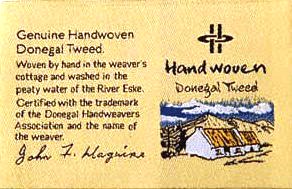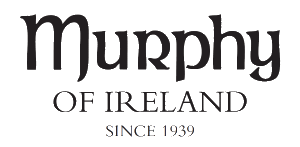Céad Míle Fáilte – Welcome to Murphy of Ireland
Murphy of Ireland have been selling high quality Irish clothing for over 80 years.
“I’m a man of simple tastes. I’m always satisfied with the best”. Oscar Wilde
 Handwoven Irish tweed jackets, waistcoats and caps have been a staple part Irish culture for generations. Spinning and weaving are an integral part of Irish culture. From 1890 to the mid-1900’s, the Handwoven Irish Tweed industry was the main source of income for almost every family in Donegal.
Handwoven Irish tweed jackets, waistcoats and caps have been a staple part Irish culture for generations. Spinning and weaving are an integral part of Irish culture. From 1890 to the mid-1900’s, the Handwoven Irish Tweed industry was the main source of income for almost every family in Donegal.
Each piece of cloth reflects the colourful and wild landscape that have inspired the weavers for hundreds of years.
Our Ancestry
 In 1939 Margaret Murphy founded Murphy & Co. in Ballybofey, County Donegal, Ireland. The business, now run by the third generation of Murphys – Margaret’s grandsons – still serves its customers from the same physical space it took over in 1939, on Main Street, Ballybofey.
In 1939 Margaret Murphy founded Murphy & Co. in Ballybofey, County Donegal, Ireland. The business, now run by the third generation of Murphys – Margaret’s grandsons – still serves its customers from the same physical space it took over in 1939, on Main Street, Ballybofey.
 Through this time, the Murphy name became synonymous with fine quality, original Irish clothing, creative Irish gifts and top quality service.
Through this time, the Murphy name became synonymous with fine quality, original Irish clothing, creative Irish gifts and top quality service.
Though she could not have predicted Internet commerce, Margaret would not be surprised by Murphy of Ireland’s continued success online. A loyal following of customers living abroad have maintained their Irish heritage by supporting the Irish craft industry through Murphy of Ireland.
Paul & Conor Murphy
 The current generation of Murphys continuing the family tradition – Paul and Conor – bring a wealth of experience in apparel, as well as customer service and international commerce. Paul works from the original premises in Ballybofey, while Conor manages all North American operations from New York.Together with a staff of employees in Ireland and North America, Paul and Conor constantly work to ensure that your experience is just as satisfying when ordering from your home as it was visiting the Murphys in Ballybofey during the past 75 years.Your privacy is always upheld at Murphy of Ireland, and all your purchases with us are guaranteed.
The current generation of Murphys continuing the family tradition – Paul and Conor – bring a wealth of experience in apparel, as well as customer service and international commerce. Paul works from the original premises in Ballybofey, while Conor manages all North American operations from New York.Together with a staff of employees in Ireland and North America, Paul and Conor constantly work to ensure that your experience is just as satisfying when ordering from your home as it was visiting the Murphys in Ballybofey during the past 75 years.Your privacy is always upheld at Murphy of Ireland, and all your purchases with us are guaranteed.All products are sourced in Donegal and surrounding counties. We take pride in the fact that we have been strongly supporting the local craft industry for the past 75 years.
On the Northwest coast of Ireland, Donegal is a tapestry of the most breathtaking landscapes; misty mountains, serene lakes, dramatic coastlines and people renowned for their special warmth and friendliness.
Irish Aran Sweaters have protected fishermen from Atlantic storms while traditional Grandfather Shirts and Nightshirts have comforted them by day and by night.

When only the best is good enough, Irish Linen was the only fabric considered appropriate for Christening Robes as the gowns invariably became treasured family heirlooms.
Murphy of Ireland continue to offer the finest Irish clothing available and we have been strongly supporting the Donegal craft industry since 1939.
 Handweaving is a centuries old craft which has survived as a way of life in Donegal. Handweaving is a tradition so old that it has no known starting point. In the sixth century the monks on the island monasteries were known to have worn homespun cloths as evident by finds on Skellig Michael off the Kerry coast. Archaeological investigations have discovered cloth which confirm a tradition of handweaving in Donegal dating back to the Middle Ages.
Handweaving is a centuries old craft which has survived as a way of life in Donegal. Handweaving is a tradition so old that it has no known starting point. In the sixth century the monks on the island monasteries were known to have worn homespun cloths as evident by finds on Skellig Michael off the Kerry coast. Archaeological investigations have discovered cloth which confirm a tradition of handweaving in Donegal dating back to the Middle Ages.
In earlier times, handweaving was part of rural life along with farming, thatching and fishing. The original tweed was a white warp, with a weft specked with colour across it, which is reflected in the granite speckled hills of the surrounding countryside. As dyeing entire pieces of cloth was such a laborious process only small balls of wool were dyed and then combed into the wool before being carded and spun. The tweed then produced was used to provide clothes and blankets for the weaver and his family.
The O’Donnells, whose castle still stands in Donegal Town, were the Chieftains in Donegal and they successfully exported handwoven tweed products throughout Europe. This healthy industry flourished until the end of the seventeenth century when the English, fearing for their own woollen industry, prohibited the trade of Irish woollen products except to England, where taxes were levied on it. As a result the trade in handweaving began to die out and the craft became a part time occupation.
After the Famine in 1846, the poor soil and severe climate made it a challenge for families to survive on their small farms by fishing and farming alone. As there was no major industrial developments in the area, the previously part time occupation of handweaving became the main livelihood for hundreds of families.
In the mid 19th century woollen production was a small scale industry. The production of handwoven tweed was well suited to the isolated homesteads and rural settlements of Donegal. The weaver in his own cottage using the wool from sheep that could withstand the harsh climate and limited food supply. The women of the household were also able to work from home carding, dyeing and spinning wool. Their children would gather the yellow gorse flowers, orange rock lichen, red fuchsias, purple blackberries and black turf to dye the cloth. These tasks could be undertaken in their own time and enabled them to earn much needed income without leaving the locality.
The process for producing Handwoven Donegal Tweed changed very little over the centuries and in the 19th century it would take an average of one month to dye, card, spin and weave a length of cloth.
In the early 1900’s Ardara was a centre for the inspection of handwoven tweed, people travelled many miles to get there on market days at the end of every month so that their work could be inspected at the depot of the Congested Districts Board. Most weaving took place during the winter months when there was less farm work to be done outdoors. The proceeds from producing tweed was an important supplement to the meagre income to be had from farming. In the 1890’s each roll of woven tweed would be worth on average £5. After the inspection the rolls of cloth were given back to the owners. If they were of satisfactory standard they would be stamped which increased their value. Merchants from towns all over Donegal came to buy tweed and even some from Belfast and London.





